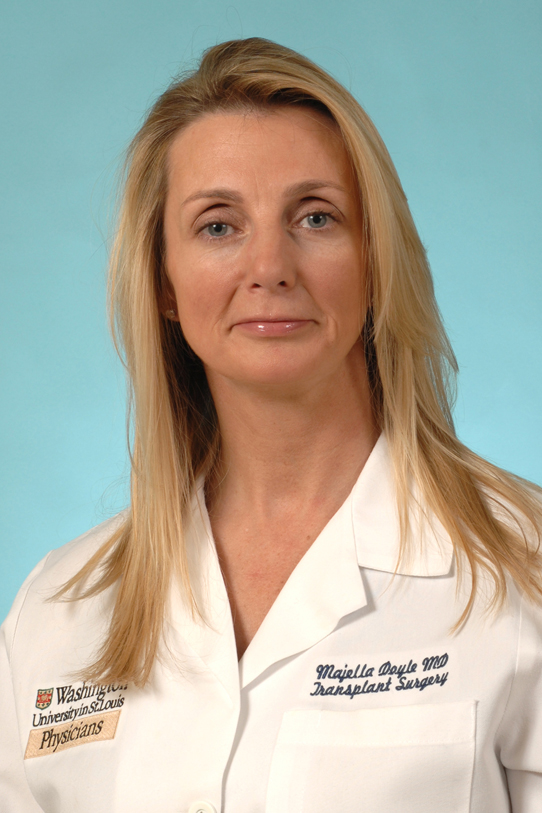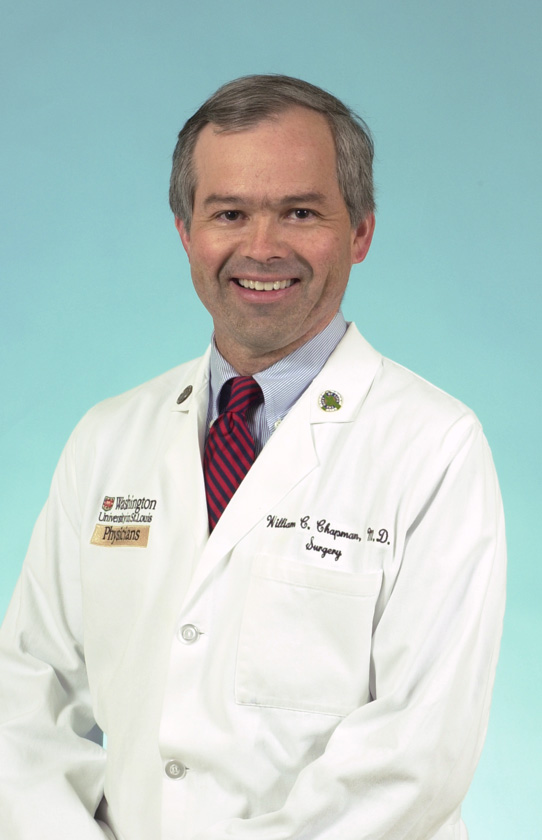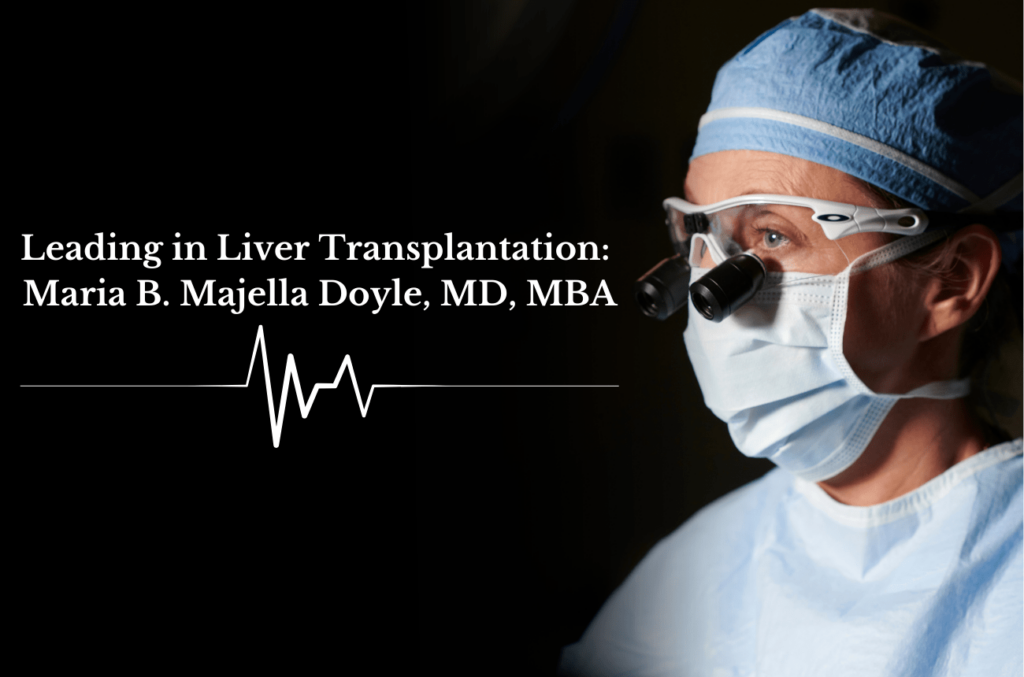For Washington University HPB-GI and abdominal transplant surgeon Maria B. Majella Doyle, MD, MBA, witnessing the courage shown by pediatric patients is one of the most rewarding aspects of being a surgeon.
As director of liver transplant at both Barnes-Jewish Hospital and St. Louis Children’s Hospital, Doyle provides lifesaving transplants to adults and children with end-stage liver disease, liver cancers including hepatoblastoma and hepatocellular carcinoma, and metabolic disorders. The transplants and other procedures she performs transform the lives of some of the sickest patients, putting them on the path to recovery and giving them the chance to live a normal healthy life.
Her impact on patient care extends beyond the operating room through groundbreaking research and critical leadership roles in the Department of Surgery at Washington University School of Medicine in St. Louis.
“We truly have the most amazing job in the world, and thanks to the organ donors and their families, we can pass on this gift of life,” says Doyle, who is the Mid-America Transplant/Department of Surgery Distinguished Endowed Chair in Abdominal Transplantation.
The Surgeon’s Surgeon
Doyle earned her medical degree and completed the Irish General Surgical Training Program at the Royal College of Surgeons in Ireland. She also completed a research fellowship in the Department of Academic Surgery at Cork University.
She joined the fellowship program at Washington University in 2005, after being recommended by one of her mentors, Dr. Gerry McEntee, who had trained with Transplant Section Chief William Chapman, MD. Both Chapman and Timothy Eberlein, MD, who was Bixby Professor and Chair of the Department of Surgery, note that it was clear from the beginning that they would want to recruit Doyle to the faculty after completing her fellowships in both HPB-GI and transplant surgery. Her surgical skill, leadership qualities and commitment to patients made her a perfect fit for the Department of Surgery.
“It was obvious that Majella became the surgeon’s surgeon,” says Eberlein. “We’re very proud of the technical and judgmental expertise of all of our surgeons. But of all of our surgeons, Majella, you’re among the best.”

Since joining the faculty, Doyle has continued to excel as a surgical leader. In 2012, while an assistant professor of surgery, she earned an MBA from Washington University in St. Louis. In addition to her roles as director of adult and pediatric liver transplant, Doyle is now director of the Abdominal Organ Transplant Fellowship Program, co-director of the Faculty Development and Mentoring Program, and Vice Chair for Clinical Affairs in the department.
A Transplant Legacy
In 1963, the first kidney transplant in the Midwest was performed by Dr. William Newton at Barnes-Jewish Hospital. By 1973, Barnes-Jewish Hospital created the Kidney Transplant Program, thanks to the leadership and pioneering spirit of Dr. Charles Anderson, who trained under Dr. Newton.
In 2009, Chapman became the surgical director of the newly established Washington University and Barnes-Jewish Hospital Transplant Center, bringing all solid organ transplants under one umbrella. The unique strengths of many disciplines combined in this center result in improved outcomes for patients needing heart, lung, kidney, liver and pancreas transplants.
“In 2019, our transplant center performed its 10,000th adult organ transplant, a milestone achieved by less than 10% of transplant programs nationwide,” says Chapman. The program is among the largest in the country, by volume, and reports excellent patient outcomes. In 2021, the liver transplant team, led by Doyle, completed an all-time high 151 transplants. Chapman emphasizes that partnerships across medical disciplines—including hepatology, nephrology, gastroenterology and infectious disease, among others—are essential to the success of the Transplant Center. “We could not do what we do without the real strength and breadth of Washington University and Barnes-Jewish Hospital.”

Partners in Transplantation
Doyle’s expertise and essential contributions to the field of transplant have not gone unnoticed.
The Mid-America Transplant/Department of Surgery Distinguished Endowed Chair in Abdominal Transplantation was established in 2020 with a generous gift to the Foundation for Barnes-Jewish Hospital from Mid-America Transplant and matched equally by the Department of Surgery. Doyle was named the inaugural chairholder in 2020 and recognized at an installation ceremony in the Eric P. Newman Education Center in 2022.
“I would like to give thanks to Mid-America Transplant Services, the Barnes-Jewish Foundation and the Department of Surgery,” says Doyle. “It is truly an honor to accept this incredible distinguished endowed chair.”
Mid-America Transplant is among the nation’s foremost organ procurement organizations (OPOs). The freestanding recovery center allows for donor optimization and shorter ischemic times before transplantation. Doyle notes that partnerships between the Transplant Center and the OPO have had tremendous benefits for patients, and that together the two are addressing some of the most critical problems in transplantation today.
Bridging the Transplant Gap
Organ transplant often provides the greatest chance at life for patients with certain severe chronic conditions. A single organ donor can save as many as seven lives, and organ and tissue donation can help many more people. Donated organs can save adults and children with diseases of the heart, lung, liver, kidney and pancreas. Unfortunately, there is a significant gap between the number of people waiting for a lifesaving transplant and the number of transplanted organs.
“Globally, we have a huge shortage: less than 10% of organ transplantation needs are met,” says Doyle. For liver specifically, she notes that surgeons in the U.S. perform almost 9,000 liver transplants annually. “If you look at the waitlist at any one time during the year, there are 25,000 patients waiting for a liver transplant. There is an enormous gap that we need to bridge.”
Increasing the number of organ donors is one way to bridge this gap.
Read more: Saying Yes to Organ Donation
Doyle, Chapman and a team of investigators at the School of Medicine are studying other promising strategies for transplanting more organs. Today, not all organs donated after cardiac death are able to be used for transplants. Some organs are considered too marginal, meaning there may be a higher chance of the transplant being unsuccessful. The current liver utilization rate in the U.S. is around 67% for recovered donor organs, Doyle says.
“We leave, as a nation, a lot of potential organs on the table that we could utilize,” Doyle says. “So how do we remedy this problem and use these organs?”
Washington University transplant surgeons and their partners at Barnes-Jewish Hospital and Mid-America Transplant have pioneered two novel approaches to bridging the gap in organ transplantation.
“One is the establishment of a donor recovery center, which drastically changes the way organs are recovered,” says Doyle. “And second are some new strategies for organ preservation that can help improve organ function.”
Recovery and Preservation
Typically, when donor organs become available, multiple teams of surgeons fly or drive to the donor hospital to recover the organs and transport them back to the transplant center. The traditional organ recovery process is challenging and time-consuming. Over the last twenty years, Mid-America Transplant has established a free-standing organ recovery center to change this process. Organ donors transferred to the recovery center are much closer to the transplant center, eliminating the lengthy travel traditionally required of surgical teams. Additionally, the organ recovery center features all the necessary equipment for organ recovery on-site. This means the surgical team can recover the organs at the ideal moment without competing for space or resources at the donor hospital. Doyle and a team of investigators reported on the significant benefits of an organ donor facility in the American Journal of Transplantation in 2014. In 2022, Mid-America Transplant completed its 2500th in-house recovery.
“The great science of medical technology can only be accomplished by great vision,” says Doyle. “Groundbreaking advances in surgery are not always a device or a treatment, but sometimes, as in this case, a change in organizational structure.”
In the last two decades, the total number of organ donors in the St. Louis region has increased by more than 140%. The total number of organs transplanted has also grown exponentially since the establishment of the organ recovery center at Mid-America Transplant, with 250% more organs transplanted annually than in the early 2000s.
Some recovered organs are not used for transplant because of their marginal status. If more of these livers could be transplanted, the gap between the number of transplants and the size of the waitlist would shrink. Washington University transplant surgeons, including Doyle and Chapman, are leading a study using normothermic machine perfusion (NMP) to improve the viability of livers that would otherwise be discarded. NMP provides an organ with a blood-based, oxygenated, nutrient-rich perfusate during the period between recovery and transplantation. This reduces the risks of lactic acid buildup and ischemia-reperfusion injury in the donor liver, and has also been shown to improve the viability of discarded livers.
The first phase of this study has had remarkable success: 11 of the 15 livers tested with NMP were used in transplantation. This means that 11 people who were otherwise unlikely to receive a donor liver could have lifesaving transplants. The study is ongoing, and Doyle expects to see even greater numbers of transplants following NMP in the future.
“By using our understanding of the physiology of the liver, we can make a prediction on the viability of an organ by using normothermic machine perfusion and increase the potential use of discarded livers to try to bridge the gap between those in need and the number of organs we have,” Doyle says.
Ultimately, Doyle says, it is all about the patients. The clinical partnerships, advanced surgical training and groundbreaking research are all centered around delivering the highest quality of care to as many transplant patients as possible.
